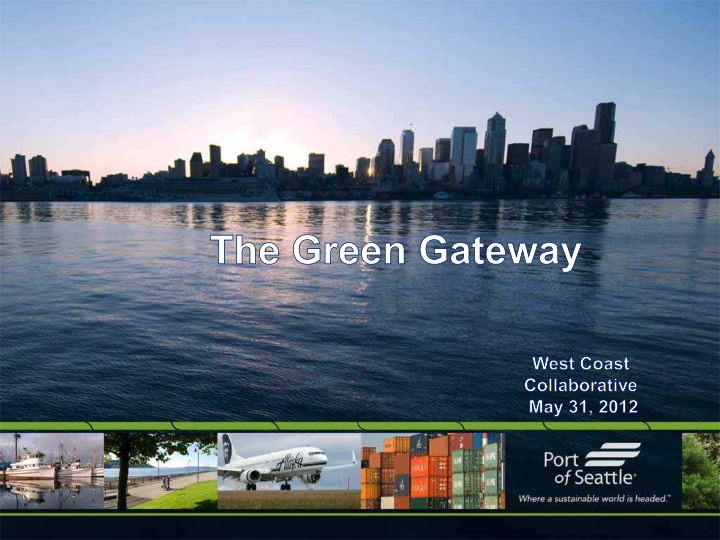



Century Agenda Over the next 25 years we will add 100,000 jobs through economic growth led by the Port of Seattle, for a total of 300,000 port-related jobs in the region, while reducing our environmental footprint.
Century Agenda • Grow seaport annual container volume to more than 3.5 Million TEUs • Triple the value of annual outbound cargo • Double the economic value of cruise traffic to Washington State • Restore, create and enhance 40 additional acre of habitat • Reduce air pollutant emissions by 50% and reduce carbon emissions from Port operations by 50%
* Herbert Engineering Corporation, 2011
Study Overview Vessel Utilization Vessel Design Slow Steaming 60%, 70%, 80%, 90% Speed 17- 24 Knots Destination Destination Routings Vessel Sizes Origin Ports Ports Cities Seattle Shanghai Chicago 4,500 TEU Oakland West Coast Hong Kong Columbus Los Angeles IPI 6,500 TEU Singapore Memphis Prince Rupert vs. Savannah Panama New York Ho Chi Minh 8,500 TEU Canal & New York Suez Canal Atlanta Busan Norfolk 12,500 TEU Tokyo Norfolk Houston
Asian ports to the Midwest through Seattle and the Panama Canal 108.7 M consumers ) Via Seattle Chicago New York Tokyo Columbus Busan Norfolk Shanghai Hong Kong Ho Chi Minh Panama Canal Singapore Via All Water
8,500 TEU Container Ship Via PANAMA CANAL Via WEST COAST CO ₂ emissions: West Coast Ports < Panama Canal 3 Avg CO ₂ emissions 2.5 Avg CO ₂ emissions 2 CO ₂ Emissions (MT) / TEU 1.5 Shanghai Hong Kong Singapore 1 Ho Chi Minh Busan Tokyo 0.5 0
Asian Ports to Chicago via Seattle and New York through Panama Canal 8,500 TEU Container Ship 3 Design Speed Slow Steaming (18 knots) 2.5 CO ₂ Emissions (MT) / TEU 2 1.5 Seattle 1 New York 0.5 0
General Results • U.S. West Coast Ports Carbon footprint advantages compared to East Coast Ports for Design deliveries to Chicago, Columbus, NY and Norfolk Speed • Seattle is the best performing port: From Asia to the Midwest (Chicago and Columbus) and the East Coast • Improves transportation efficiency as the vessel speed is reduced = emissions go down Slow • Seattle in most cases has the smallest carbon footprint to Chicago and Columbus Steaming • LA has the smallest CO ₂e emissions for deliveries to Memphis from Shanghai, Hong Kong, Busan and Tokyo • Loss of vessel utilization decreases CO ₂e transportation Utilization efficiency
Green Gateway Carbon Calculator http://www.portseattle.org/seaport/cargo/CarbonCalc.shtml
Puget Sound Maritime Air Emissions Inventory • 2005 activity-based inventory • First to include greenhouse gases • Coordinated with similar effort in Canada • Northwest Ports Clean Air Strategy formulated as a result of inventory • Inventory is being updated with 2011 data and will show progress made since 2005
2005 Diesel Particulate Matter Puget Sound Clean Air Agency Region
Northwest Ports Clean Air Strategy Focused on diesel particulate matter and greenhouse gases Clear, measurable performance measures Ocean-going vessels Cargo handling equipment Trucks Rail Harbor vessels Encourage ongoing innovation and efficiencies short term (2010) and long term (2015) targets 2012 Strategy Update will add 2020 targets
Ocean Going Vessels 73% of frequent calling vessels met the NWPCAS goal Shore power at 2 cruise berths At-Berth Clean (ABC) fuels incentive program • Tiered $1200-$2850 incentive for use of < 0.5% sulfur fuel 10 Participating Lines •2011: 375 Vessels •2010: 400 Vessels •2009: 235 Vessels Green Gateway Partners Recognizes carriers for environmental programs that go beyond ABC fuels and environmental requirements.
Cargo-Handling Equipment • 61% are Tier 2, 3 or 4 • Level 1, Level 2 and Level 3 exhaust retrofits • Anti idling pilot project underway. • 100% of CHE used ultra low sulfur diesel fuel and/or biodiesel blends • Grants from EPA, PSCAA, and Ecology
Rail and Harbor Vessels • Harbor Vessels – Focus on cleaner fuels and engines • Rail: – Encourage SmartWay participation – BNSF North SIG Yard electrification – Louis Dreyfus switcher engine anti-idling
Clean Truck Program Developed collaboratively and implemented in 2011 • 100% MY 1994 or newer • Terminal operators administer • Drayage Truck Registry in place • RFID coming on board in 2012 • Next: MY 2007 or newer in 2015 ScRAPS • $5,000 incentive • 280 trucks scrapped
Conclusion
Recommend
More recommend